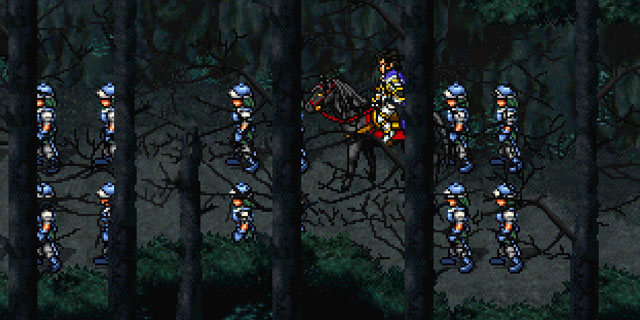
As brutal and terrifying as it is in real life, war can make for a compelling backdrop for stories, both real and fictitious. The desperation of the situation, emerging technological advances and influences of bigger-than-life personalities are greatly appealing to historians and enthusiasts (rarely the participants). The optimistic future of Star Trek steps aside during the Dominion War storyline in Deep Space Nine; many fans would say it was for the better. “Yesterday’s Enterprise” is considered one of the best Star Trek: The Next Generation episodes, taking place in an alternate reality smack dab in the middle of a war between the Klingons and Federation.
Countless movies have received great accolades for depicting the ultimate conflict of man, from Bridge on the River Kwai to Saving Private Ryan to The Hurt Locker. The themes, emotions and complexities that a war brings will not stop being adapted into movies, games, books, television, plays, poetry and paintings because the source material is simply too rich. Too important.
Games have tackled war before, that’s nothing new. The Call of Duty franchise is about as valuable an IP as there is. Real-time strategy games create new wars and emulate old ones as their theater. But one RPG series in particular takes particular pride in having war as the main focus. One that tosses away the notion that games need to have a love story, or a small cast. The series is Suikoden, and the second game is the best of them all.
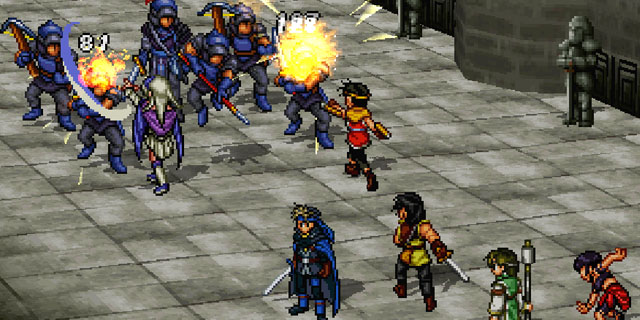
Suikoden II stuck with me, like all great games do. The graphics are much improved over the original. There were 108 allies to recruit (same as in the first, third… well, all of them). That may seem like a lot (it is), but the central concept of Suikoden is that you play as a character with humble beginnings, only to eventually lead an entire army against an oppressive, evil kingdom or city-state. That’s going to take more than your standard group of six or seven, you know. One person can only do so much, no matter what magical rune they may be given by a mysterious sage.
Suikoden II‘s story is excellent. You start off as a junior member in the Highland army with your best friend, Jowy. Something tragic happens to set the wheels in motion, but it’s not predictable. When the villains scheme, no matter how nefarious it is, it makes sense in the world of Suikoden. Refreshing. It’s war. Most cut scenes involve political and military leaders plotting how they’re going to win. The brilliant part is that you see both sides. It’s not The Wire, but it’s a nice change of pace to see the villains also hovered over a table, frantically trying to figure out what to do. Many different personalities come in and out of the picture. And one segment stands above the rest. A highlight, in a game filled with them. It features the deliciously sadistic villain, Luca Blight.
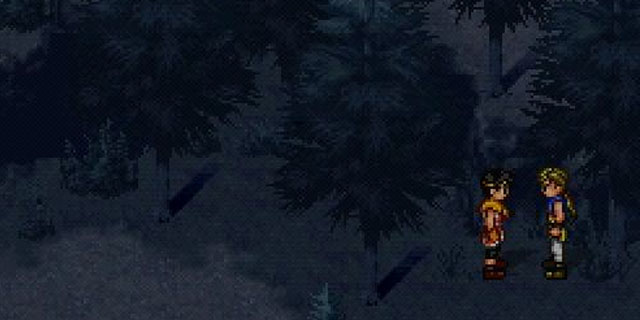
Your friendship with Jowy is tested, to say the least. He changes sides, but you’re not entirely sure what to make of it. Are his actions simply a means to an end? He’s just doing all these things to protect his wife… and you (the main character) and your sister. Right? Then why is he on the same side as Luca Blight? A prince that makes Joffrey Baratheon look civil? Blight sacrifices lives throughout the game, most of them innocent, and seems to enjoy doing so. The developers gave him a good background story, resulting in a healthy fear and understanding. Sympathy, even? And a simmering rage. You want to kill him. This is war, after all, right? It’s okay to feel that way.
Through a betrayal on Blight’s side, your army comes to realize that your enemies are about to attack during the night. You set an ambush. You’re trying to defend your camp and army, yes, but the main goal of the ambush is obvious: kill Luca Blight. Not capture him, not disarm him for questioning (not after breakfast!), but straight-up murder him. And you’re not fighting fair.
You rarely see the odds stacked in your favor for this kind of fight. You know he’s coming, he has no idea you know. To face the seemingly-main enemy of the game at this stage in the story usually means that there is another fight in the future. The bad guy will just get away, cursing your name, or killing a party member in the process. Not this time.
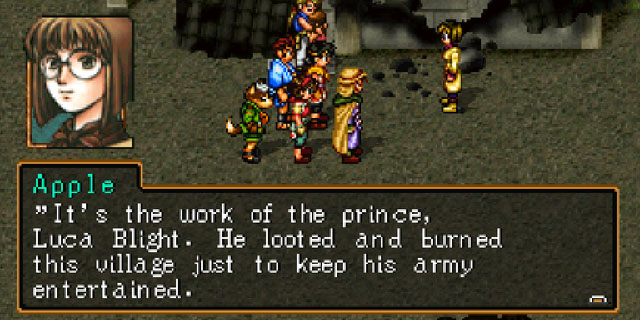
Blight marches into the woods on horseback, at night, surrounded by his soldiers. You’re not exactly sure how the ambush will start, but you find out very quickly. A flurry of arrows decimates Blight’s force, killing most around him and, in a startlingly unexpected show of brutality, his horse. Dead. Covered with arrows.
Blight’s soldiers surround him, trying to protect him. They soon fall. Arrows in the dark find their mark. It is here where you take over.
Suikoden II gives you the option of having up to six party members. You take Blight on with five of his cronies; they fall quickly (so hard to find good help these days), and it’s soon six on one. When you deal enough damage, the scene fades back to the woods with Blight staggering away with arrows stuck in him. You don’t let him get away. Your second group of six is waiting and ready for him. Game on.
You fight him for a third time before the final cutscene. More ambushes await, more archers in the dark. Blight finally falls. He does not die a noble death. He complains that a weaker group killed him, and moans about how this could possibly happen. (Honestly, not the strongest writing.) Once he dies, the realization sets in. He’s not coming back. He’s not going to be revived by a wizard, or haunt your dreams as a ghost. Your group disperses to celebrate. Blight’s betrayer views the aftermath and leaves, satisfied.
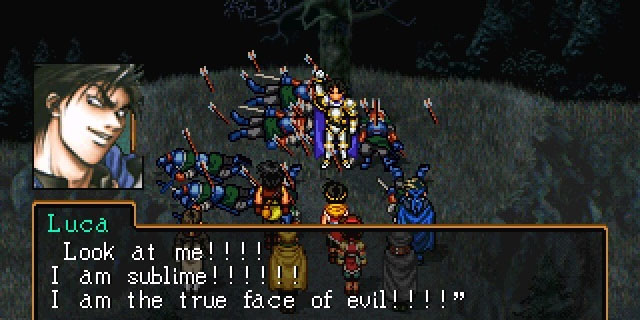
Quite a scene. You take out the main villain with a surprise attack; not exactly noble. Sure, you fight him one-on-one in a duel with your main character, but that’s after you’ve fought him with three different groups of 6six and peddled him with arrows. Sure it’s war, but… man. This was cool. This was gritty. This was desperate. Your group goes to celebrate, but I didn’t really feel like celebrating. It drained me, but filled me with an exhilaration. Why?
The scenario works for a number of reasons. Primarily, Blight is a nasty human being who takes glee in murdering innocent people. Secondly, the scene is unique; this is not how you generally take out the main bad guy in games. But, since the setup makes you feel desperate (your superior screams to not let Blight get away during the ambush), and it’s part of war, you feel justified. You’re playing dirty, but Blight did too. He had it coming. This opportunity was too good to pass up. The world is a better place. Right?
Other RPG series have tried the assassination angle. Final Fantasy VIII had an admittedly-cool setup for their version, but it didn’t have the same emotional punch. You fail, first of all. Secondly, you’re not an army in a war, but a group of emotionally adjusting teenagers at a school. Your target is nowhere near Blight’s level of villainry.
Suikoden II succeeds in no small part due to the emphasis of the group. The game encourages you to try out new team members, both in battle (low level characters catch up to high level characters after only a few battles) and outside (the variety in look, personality and fighting style). For the attack on Blight, you must have 18 party members who are high in level and adequately equipped. Having a weak group will mean Blight’s victory, guaranteed. He hits hard, like a psychopath video game villain should. When the assassination is successful, you feel a great sense of accomplishment; you didn’t just defeat him with your main character, but 17 others.
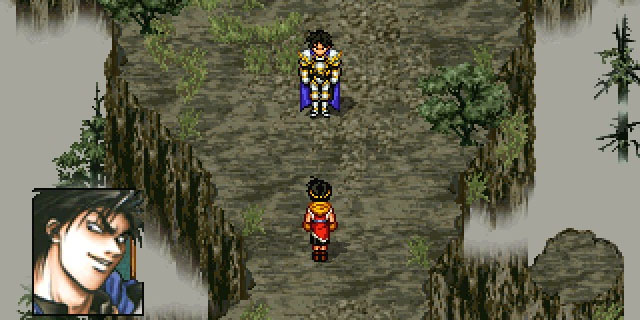
Playing the game at the time didn’t bring up these thoughts. It was just amazing to have the opportunity to have three separate groups take on one super-tough bad guy. The setting was dark, it fit. And to be perfectly honest, it felt great fighting dirty in a game for once. Nobility and honor have no place in war; Suikoden II knows this.
I’d love to see this kind of scenario in games more. Show me the conflicted thoughts of the main characters as they plan an assassination. Show me why it’s necessary, or why they think it’s necessary. Build up the villain, present us a challenging and unique fight, and have it affect the rest of the story. Give us the details. Where is the ambush taking place? What could go wrong? Who takes the shot? Those kinds of details will go a long way in establishing a scene that will stay in gamers’ minds.
Reading about our own past wars has unnerved me as I get older. Tim Cook’s excellent two-series volume about Canadian troops in World War I is a very tough, but worthwhile read. Studs Terkel’s The Good War, an oral history of World War II, is one of the best books I’ve ever read. Emotions I feel now as I learn the details of these great conflicts didn’t exist when I was younger. Maybe that’s why I still enjoy war as a setting in video games. I know that nobody was actually hurt in the making of the project.



















